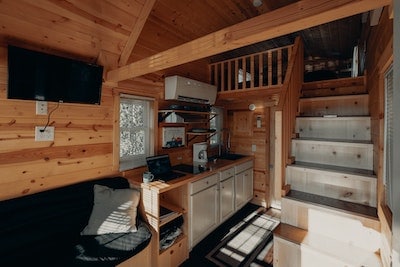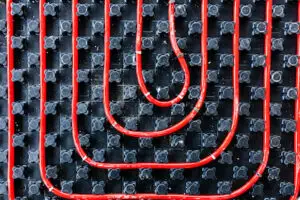How Should You Heat Your Small Home?
Switching to smaller homes continues to gain traction as a popular trend in the United States. From a simple downsize to buying tiny homes, Americans are beginning to appreciate that less room often means less expense and, as a consequence, an often simpler lifestyle. However, with small homes rising popularity comes uncertainty about the significant differences in having a smaller-than-normal house.
So, what is the best heating system for a small house? The best option to heat your small house could be to use a propane or natural gas infrared heater. Infrared heaters are efficient heater options for small homes due to their ability to heat small spaces while using less energy than other options. While larger homes are harder to heat with infrared heaters, they are great options for a house with less space. One of the main differences is heating this smaller area, opposed to a larger home with more rooms and square footage to cover.
Propane is clean-burning and relatively less expensive than electricity, and you can easily find an appropriate heater for your space. Rather than spending a ton of money with classic heating measures, a propane heater will be inexpensive and efficient when compared with other options. Keep reading for more tips on heating your small home, no matter the floor plan.
Heating a Small Home With an Open Floor Plan
A small home with an open plan certainly has plenty to admire. Often smaller homes include a more open layout because it offers more room overall and usually more light. Smaller homes can seem cramped. However, an open layout helps expand the space and feel of a smaller home.
Of course, open-plan homes aren’t perfect. Heating a more open design of a home can be a challenge, especially for affordability. Particularly in the winter and summer months, heating and cooling a more open house can be costly. While we recommend using an infrared propane or gas heater, there are some other ways to help efficiently heat your home.
Insulation
When it comes to ensuring your small home stays nice and warm, insulation can play a crucial role. Cracks, which often appear near windows and doors, can let in air and cause the air to cool faster than usual. This cold air means your heating source will have to work even harder to ensure the house is warmed, thus causing your small place to be less warm while spending more money!
Ensure this doesn’t happen by carefully examining your home’s perimeter and caulking/sealing these unwanted spots. If you are still noticing that there is cool air coming from somewhere in your home, you may need to retrofit your insulation. Often, it’s best to call a professional who can examine your home and let you know the best next steps to ensure your home stays warm without breaking the bank.
 Window Treatments
Window Treatments
Speaking of letting heat in or out of your home, another great tip to efficiently heat your home is to use warming window treatments. Did you know that your windows can let in more cold? Hanging curtains specifically made to keep in heat can be a great option during the winter when you’re trying to heat your home.
Shutters can also be an excellent option for blocking cold air from entering your house through your windows. Shutters are functional and can double as decoration, adding a classy touch to the exterior of your home.

Supplement
If you find that your home parts are still cold, especially if your home doesn’t have a very open floorplan, you can supplement your heating source. Whether adding an extra natural gas heater or tiring a child-safe radiator, or even a baseboard heater, there are many affordable options to ensure your small home is efficiently heated.
Ceiling Fans
You might not think of using the ceiling fans when the weather drops in temperature. However, if you’re using an HVAC unit for your heating, a fan can help to circulate the heat downward towards you and your family. You should be able to adjust your ceiling fan setting so that the fan’s path moves backward, aiding this downward circulation.
If you aren’t sure how to do that, there should be instructions in the manufacturer’s information. If you’ve lost the instructions, you can try googling your fan for more details on how to turn it to the “backward” setting. Additionally, using a ceiling fan will help to reduce the effect of humidity on your home.
Entry Rooms
If you’re trying to heat a tiny home, a rule of thumb is to reduce heat transfer. If you’re building your small house and trying to find the best ways of heating and cooling your home, you may want to add an extra entry or “mud” room. These can be incredibly useful in keeping the cool air outside and the warmth inside you during the winter months.
Even if you opt for a temporary curtain or door between the exits and the rest of your homes, you could potentially save some money on your heating costs.
Floors
Another great way to heat your home is to install radiant heating underneath the floor. Now, having heated floors might sound too good to be true! But your local HVAC company will most likely be able to install underfloor heating if you’re building or remodeling a home.
Wall heaters are excellent! However, having radiant flooring can be a great way to add some extra warmth to your home. And since your home is small, it will be more affordable than installing in a large house. If your not building or in the market for new floors, you can try out some more cozy rugs to add warmth and style to your tiny home.
 Safely Heating a Small Home
Safely Heating a Small Home
In the hustle and bustle of getting ready for the winter months, you might forget that heating sources will necessitate extra safety precautions.
When you are heating any home, whether large or small, you should always consider overall safety. From the air quality inside your home to ensuring that your heating source is clear of any potential fire hazards, you should always keep your house’s safety in mind. Particularly in the winter months, ensuring the security of your home is vital.
So, what is the best way to ensure the safety of your home when using heaters? Heating sources with a flame are often more efficient and affordable than alternatives. However, you need to be especially careful and attentive to these heaters. If you have children, you must ensure they do no touch a heater on the floor, which could be a significant hazard.
It’s always best to have heating sources that a child cannot touch or have a grate or some obstruction that a child cannot touch. However, be sure that whatever you use to hamper your child’s ability to reach heaters is also made for a heater, or it could become a fire hazard itself.
What about ventilation for your small home when using a heater? Proper airflow is another essential consideration! When using a heater or other heat source, you want to be sure that your home has adequate ventilation so that the air-quality remains excellent for you and your family. It’s ideal to have an expert look at your space to ensure your home is safe and give feedback on improving your home’s safety and air quality in the colder months.
Things to Consider When Heating a Small Home
Small homes are an excellent option for most families. They offer a more simple lifestyle and can help you cut back on overall costs. You can save a significant bit of money in a smaller house during the hot and the cold months. However, there are differences that you’ll have to consider.
It can be most efficient to use a propane or natural gas heater for your small house. You’ll need to keep in mind, however, the safety aspects of operating a heater. Especially if you have kids, you’ll want to ponder what the most efficient and safe heating option is best for your home.
We recommend using a natural gas or propane heater to efficiently and affordably heat your home. However, we also explored plenty of other tips to help you keep your smaller home heated efficiently. Be sure that you have the proper insulation in your walls.
Not only walls may need extra insulation, but also the spaces between your doors and windows and the rest of the house. Consider ways to shield the interior of your from the cold to keep the warm air where it belongs.
These tips will help you save money and help with the safety of heating your home in the winter. Conclusively, when heating a small house, you will want to consider all of the criteria we have discussed: efficiency, safety, insulation, and cost. When in doubt, be sure to refer to professionals in your area who can help make sure your home is adequately heated.
Additionally, professionals can ensure that your home doesn’t have fire hazards, and they can give you more tips on the safety and insulation of your home. You can find more home tips from experts here!

